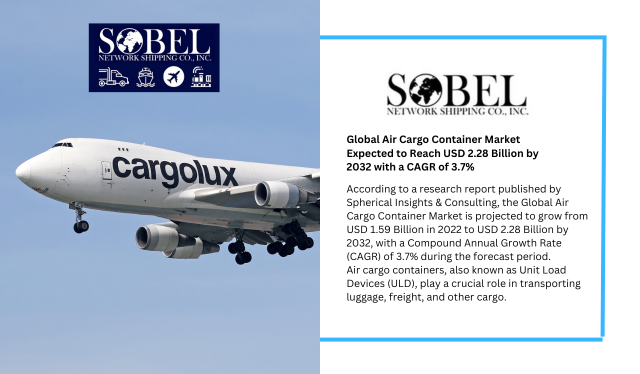According to a research report published by Spherical Insights & Consulting, the Global Air Cargo Container Market is projected to grow from USD 1.59 Billion in 2022 to USD 2.28 Billion by 2032, with a Compound Annual Growth Rate (CAGR) of 3.7% during the forecast period.
Air cargo containers, also known as Unit Load Devices (ULD), play a crucial role in transporting luggage, freight, and other cargo. These solid vessels, which include refrigerated and non-refrigerated containers, enable the efficient transportation of large cargo volumes in a single unit. The size and design of these containers vary based on cargo type and consumer preferences. They are designed to be compatible with cargo handling systems and fit within the cargo hold of aircraft.
The global air cargo container market is witnessing growth due to the expanding e-commerce industry, which demands faster delivery and an efficient supply chain. Third-party logistics companies are increasingly incorporating air cargo as a vital mode of transportation to meet these demands. Perishable and high-value goods such as food and beverages, pharmaceuticals, biological products, computers, and consumer electronics are among the fastest-growing trade flows and are frequently transported by air. As cross-border trade continues to expand, the demand for air cargo is expected to rise. In response, emerging countries are converting and upgrading existing airports into cargo terminals, further driving the development of the air cargo container market. However, price fluctuations in aviation fuel pose a significant challenge to the market.
During the forecast period, the refrigerated segment is projected to grow at the highest CAGR in the global air cargo container market. The pharmaceutical market, in particular, requires specialized and regulated transportation, making refrigerated containers crucial.
The global air cargo container market is categorized into refrigerated and non-refrigerated containers, with the refrigerated segment expected to experience the fastest growth during the forecast period. Additionally, the metal segment is anticipated to hold the largest share in the global air cargo container market. Aluminum and steel are the primary materials used for ULD containers, with aluminum being favored for its lightweight and corrosion resistance.
Furthermore, the new sales segment is expected to exhibit the highest growth rate in the global air cargo container market. The increasing aircraft fleet will drive the demand for new ULD containers.
In terms of regional analysis, Asia Pacific is projected to dominate the global air cargo container market, driven by the expansion of trade operations in industries such as pharmaceuticals, FMCG, and electronics. The region has major competitors who employ innovative approaches to pharmaceutical product transportation. North America is expected to experience the fastest growth rate in the market due to its active B2B buyer network, increased aircraft deliveries, and the widespread use of wide-body aircraft.
The report includes a competitive analysis of key organizations in the global market, evaluating their product offerings, business overviews, geographic presence, strategies, segment market share, and SWOT analysis. Major vendors in the Global Air Cargo Container Market include Nordisk Aviation, Granger Plastics, Air Cargo Containers LLC, Royal DSM N.V, DokaSch GmbH, Zodiac AirCargo Equipment, Envirotainer, Safran Aerosystems, VRR Aviation, ACL Airshop, Unilode, CHEP, Jettainer, and others.


